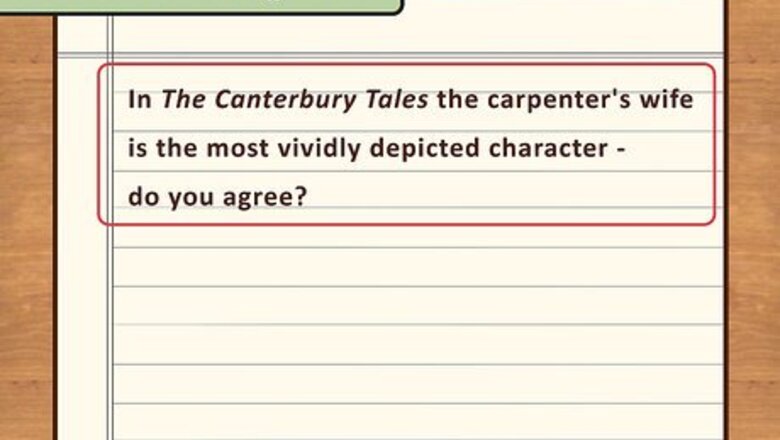
views
Preparing to Write a Critical Essay
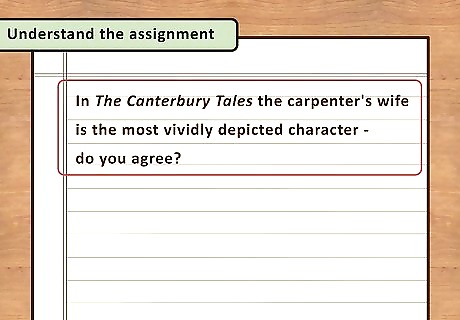
Make sure that you understand the assignment. As soon as your teacher assigns the paper, read the guidelines and highlight anything that you do not understand. Ask your teacher to clarify the instructions if anything seems unclear or if you just don’t understand the assignment.
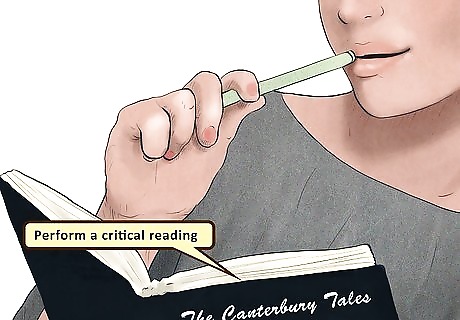
Perform a critical reading of your source(s). A critical essay assignment asks you to evaluate a book, an article, a movie, a painting, or some other type of text. In order to perform a critical analysis of any text, you need to become very familiar with the primary text. Get to know the text inside and out by reading and rereading it. If you have been asked to write about a visual text like a film or piece of art, watch the film multiple times or view the painting from various angles and distances.
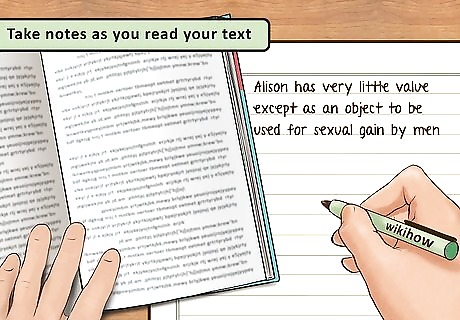
Take notes as you read your text. Taking notes as you read will help your to remember important aspects of the text, and it will also help you to think critically about the text. Keep some key questions in mind as you read and attempt to answer those questions through your notes. What is the text about? What are the main ideas? What is puzzling about the text? What is the purpose of this text? Does the text accomplish its purpose? If not, why not? Is so, how so? Don't: summarize the plot — you should already be familiar with it.Do: jot down thoughts that may guide your paper: Does he mean __? Does this connect to __?
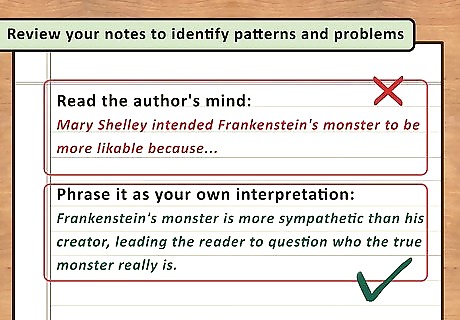
Review your notes to identify patterns and problems. After you have finished reading and taking notes on your text, look over your notes to determine what patterns are present in the text and what problems stand out to you. Try to identify a solution to one of the problems you have identified. For example, you may notice that Frankenstein's monster is often more likable than Doctor Frankenstein, and make an educated guess about why this is. Your solution to the problem should help you to develop a focus for your essay, but keep in mind that you do not need to have a solid argument about your text at this point. As you continue to think about the text, you will move closer to a focus and a thesis for your critical analysis essay. Don't: read the author's mind: Mary Shelley intended Frankenstein's monster to be more likable because...Do: phrase it as your own interpretation: Frankenstein's monster is more sympathetic than his creator, leading the reader to question who the true monster really is.
Conducting Research

Find appropriate secondary sources if required. If you are required to use sources for your critical essay, you will need to do some research. See your assignment guidelines or ask your instructor if you have questions about what types of sources are appropriate for this assignment. Books, articles from scholarly journals, magazine articles, newspaper articles, and trustworthy websites are some sources that you might consider using. Use your library’s databases rather than a general internet search. University libraries subscribe to many databases. These databases provide you with free access to articles and other resources that you cannot usually gain access to by using a search engine.

Evaluate your sources to determine their credibility. It is important to use only trustworthy sources in an academic essay, otherwise you will damage your own credibility as an author. Using the library’s databases will also help to ensure that you are getting plenty of trustworthy sources for your paper. There are several things that you will need to consider in order to determine whether or not a source is trustworthy. The author and his or her credentials. Choose sources that include an author’s name and that provide credentials for that author. The credentials should indicate something about why this person is qualified to speak as an authority on the subject. For example, an article about a medical condition will be more trustworthy if the author is a medical doctor. If you find a source where no author is listed or the author does not have any credentials, then this source may not be trustworthy. Citations. Think about whether or not this author has adequately researched the topic. Check the author’s bibliography or works cited page. If the author has provided few or no sources, then this source may not be trustworthy. Bias. Think about whether or not this author has presented an objective, well-reasoned account of the topic. How often does the tone indicate a strong preference for one side of the argument? How often does the argument dismiss or disregard the opposition’s concerns or valid arguments? If these are regular occurrences in the source, then it may not be a good choice. (Note, however, that literary criticism often presents a very strong preference for one reading; this is not usually considered "bias" because the field of literary study is inherently subjective.) Don't: dismiss an author for favoring one point of view.Do: engage critically with their argument and make use of well-supported claims. Publication date. Think about whether or not this source presents the most up to date information on the subject. Noting the publication date is especially important for scientific subjects, since new technologies and techniques have made some earlier findings irrelevant. Information provided in the source. If you are still questioning the trustworthiness of this source, cross check some of the information provided against a trustworthy source. If the information that this author presents contradicts one of your trustworthy sources, then it might not be a good source to use in your paper.
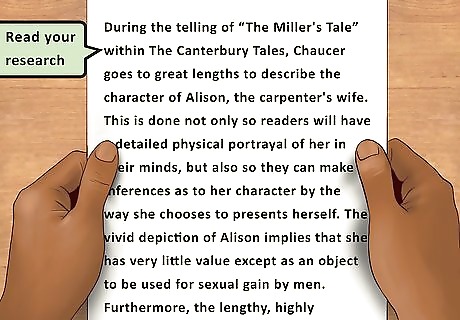
Read your research. Once you have gathered all of your sources, you will need to read them. Use the same careful reading strategy that you used when you read your primary source(s). Read the sources multiple times and make sure that you fully understand them.
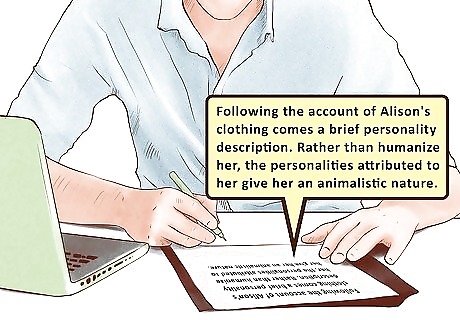
Take notes while you read your sources. Highlight and underline significant passages so that you can easily come back to them. As you read, you should also pull any significant information from your sources by jotting the information down in a notebook. Clearly indicate when you have quoted a source word for word by putting it into quotation marks and including information about the source such as the author’s name, article or book title, and page number. Don't: highlight a phrase just because it sounds significant or meaningful.Do: highlight phrases that support or undermine your arguments.
Writing Your Essay
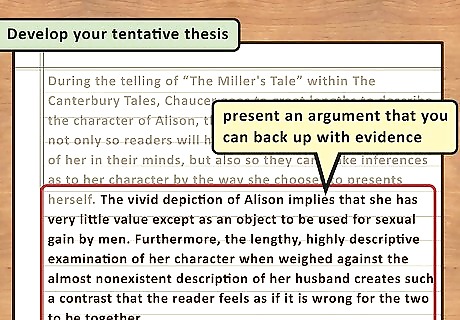
Develop your tentative thesis. Once you have developed your ideas about your primary source and read your primary sources, you should be ready to write a thesis statement. Effective thesis statements express the main focus of a paper and state an arguable claim. You may find it helpful to use a multi-sentence thesis statement, where the first sentence offers the general idea and the second sentence refines it to a more specific idea. Make sure your thesis provides enough detail. In other words, avoid simply saying that something is "good" or "effective" and say what specifically makes it "good" or "effective." Place your thesis statement at the end of your first paragraph unless your instructor tells you to place it elsewhere. The end of the first paragraph is the traditional place to provide your thesis in an academic essay. For example, here is a multi-sentence thesis statement about the effectiveness and purpose of the movie Mad Max: Fury Road: "Many action films follow the same traditional pattern: a male action hero (usually white and attractive) follows his gut and barks orders at others, who must follow him or die. Mad Max: Fury Road is effective because it turns this pattern on its head. Instead of following the expected progression, the movie offers an action movie with multiple heroes, many of whom are women, thereby effectively challenging patriarchal standards in the Hollywood summer blockbuster." Don't: include obvious facts (Mad Max was directed by George Miller) or subjective opinions (Mad Max is the greatest movie of 2015).Do: present an argument that you can back up with evidence.

Develop a rough outline based on your research notes. Writing an outline before you begin drafting your essay will help you to organize your information more effectively. You can make your outline as detailed or as scant as you want. Just keep in mind that the more detail you include in your outline, the more material you will have ready to put into your paper. You may want to use a formal outline structure that uses Roman numerals, Arabic numerals, and letters. Or, you may want to use an informal "mind-map" type of outline, which allows you to gather your ideas before you have a complete idea of how they progress.
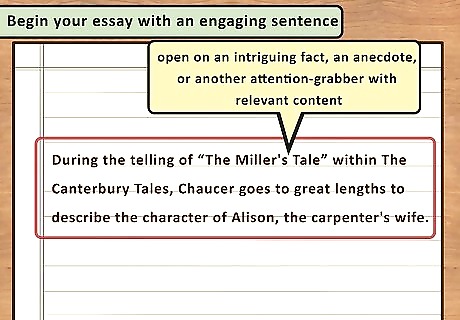
Begin your essay with an engaging sentence that gets right into your topic. Your introduction should immediately begin discussing your topic. Think about what you will discuss in your essay to help you determine what you should include in your introduction. Keep in mind that your introduction should identify the main idea of your critical essay and act as a preview to your essay. Don't: start with a cliche such as In modern society...; Throughout history...; or The dictionary defines....Do: open on an intriguing fact, an anecdote, or another attention-grabber with relevant content. Other good techniques to open an essay include using a specific, evocative detail that links to your larger idea, asking a question that your essay will answer, or providing a compelling statistic.
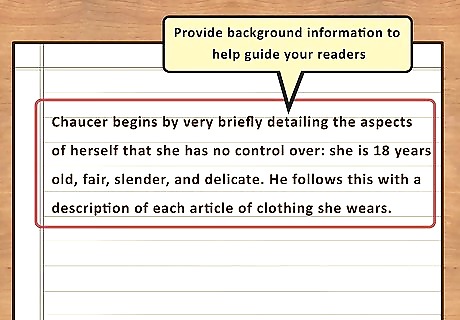
Provide background information to help guide your readers. Providing adequate background information or context will help to guide your readers through your essay. Think about what your readers will need to know in order to understand the rest of your essay and provide this information in your first paragraph. This information will vary depending on the type of text you have been asked to write about. Don't: summarize parts of the plot irrelevant to your essay.Do: tailor your introduction to your audience. A conference of English professors needs less background info than a blog readership. If you are writing about a book, provide the name of the work, the author, and a brief summary of the plot. If you are writing about a film, provide a brief synopsis. If you are writing about a painting or other still image, provide a brief description for your readers. Keep in mind that your background information in the first paragraph should lead up to your thesis statement. Explain everything the reader needs to know to understand what your topic is about, then narrow it down until you reach the topic itself.
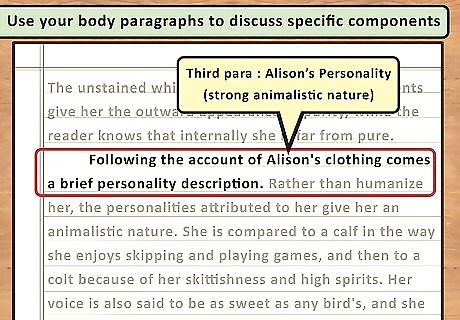
Use your body paragraphs to discuss specific components of your text. Rather than trying to talk about multiple aspects of your text in a single paragraph, make sure that each body paragraph focuses on a single aspect of your text. Your discussion of each of these aspects should contribute to proving your thesis. For each body paragraph, you should do the following: Provide a claim at the beginning of the paragraph. Support your claim with at least one example from your primary source(s). Support your claim with at least one example from your secondary sources.
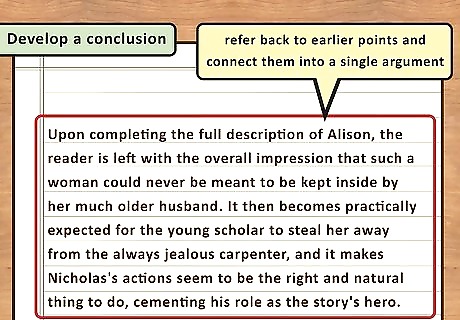
Develop a conclusion for your essay. Your conclusion should emphasize what you have attempted to show your readers about your text. Before you write your conclusion, spend some time reflecting on what you have written so far and try to determine the best way to end your essay. There are several good options for ending an academic essay that might help you decide how to format your conclusion. For example, you might: Summarize and review your main ideas about the text. Explain how the topic affects the reader. Explain how your narrow topic applies to a broader theme or observation. Call the reader to action or further exploration on the topic. Present new questions that your essay introduced. Don't: repeat the same points you made earlier in the essay.Do: refer back to earlier points and connect them into a single argument.
Revising Your Essay
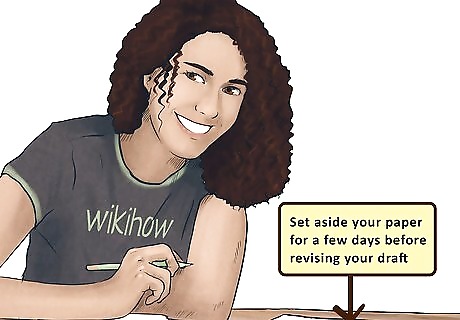
Set aside your paper for a few days before revising your draft. By taking a break after you have finished drafting your paper, you will give your brain a rest. When you revisit the draft, you will have a fresh perspective. It is important to begin writing a paper far enough ahead of time to allow yourself a few days or even a week to revise before it is due. If you do not allow yourself this extra time, you will be more prone to making simple mistakes and your grade may suffer as a result.
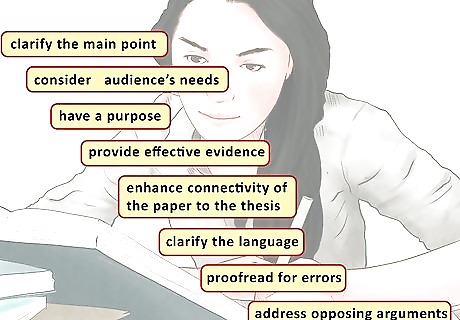
Give yourself sufficient time to do a substantive revision that clarifies any confusing logic or arguments. As you revise your paper, you should consider multiple aspects of your writing to make sure that your readers will be able to understand what you have written. Consider the following questions as you revise: What is your main point? How might you clarify your main point? Who is your audience? Have you considered their needs and expectations? What is your purpose? Have you accomplished your purpose with this paper? How effective is your evidence? How might your strengthen your evidence? Does every part of your paper relate back to your thesis? How might you enhance these connections? Is anything confusing about your language or organization? How might your clarify your language or organization? Have you made any errors with grammar, punctuation, or spelling? How can you correct these errors? What might someone who disagrees with you say about your paper? How can you address these opposing arguments in your paper?
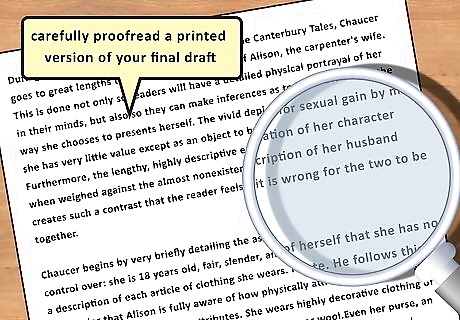
Complete your paper by carefully proofreading a printed version of your final draft. Read your paper out loud to make sure that you have identified any typos, grammatical errors, wordy or incomplete sentences, and other minor mistakes that may negatively affect your grade. Once you have identified any minor errors, revise your paper and print a fresh copy to turn in. If you are submitting your paper online or through email, check with your teacher or professor to find out what format s/he prefers. If you have used any textual formatting in your paper, you may wish to save it as a PDF file to preserve your formatting.














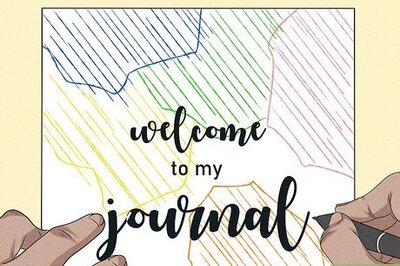



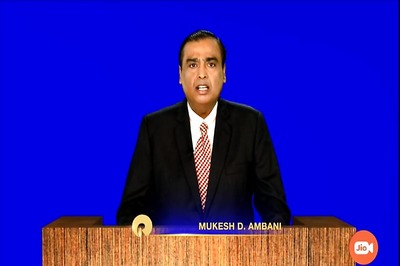

Comments
0 comment